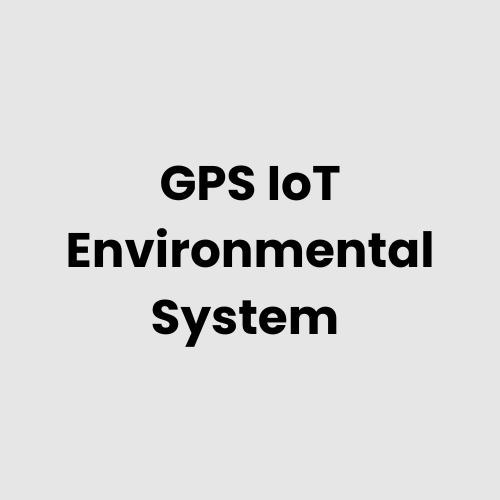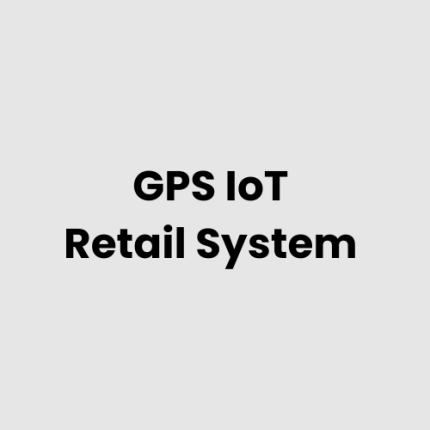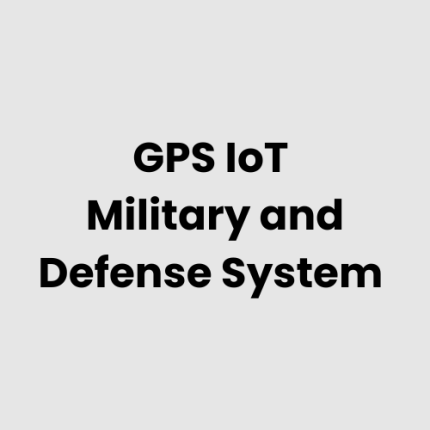GPS IoT Environmental System
Discover the technical architecture, hardware, and deployment of GAO Tek’s GPS IoT Enabled Environmental IoT System for efficient environmental monitoring.
Description
Technical Architecture of GPS IoT Enabled Environmental IoT System
The GPS IoT Enabled Environmental IoT System from GAO Tek Inc. features a multilayered architecture designed to monitor environmental conditions in real time.
- Perception Layer: Incorporates sensors for environmental data, including air quality, water quality, soil composition, and meteorological parameters. GPS modules ensure precise location tagging.
- Network Layer: Utilizes IoT gateways and cellular, satellite, or LPWAN communication protocols to transmit data. Edge computing optimizes real-time analysis.
- Processing Layer: Integrates cloud-based platforms for data aggregation, storage, and AI-driven analytics. Local servers can supplement for on-site processing.
- Application Layer: Provides intuitive dashboards, mobile apps, and APIs for end-users to monitor and manage environmental data effectively.
List of Hardware for GPS IoT Enabled Environmental IoT System
- Environmental sensors: Air quality, water quality, and soil condition sensors
- GPS modules for location tracking
- IoT gateways with edge computing capabilities
- Data loggers for on-site storage
- Communication modules: Cellular, satellite, or LPWAN
- Solar panels and battery packs for remote operation
- Weather monitoring stations
- Ruggedized enclosures for hardware protection
- IoT-enabled cameras for visual monitoring
- Local server equipment for data processing
Physical Placement Considerations for Hardware
- Proximity to Monitored Zones: Sensors should be positioned near target areas such as water bodies, forests, or industrial zones.
- GPS Signal Optimization: Ensure unobstructed access to satellites by placing GPS modules in open spaces.
- Environmental Protection: Use weatherproof enclosures to shield hardware from extreme weather.
- Power Access: Leverage solar panels or robust batteries for installations in remote locations.
- Accessibility: Position devices for easy maintenance and calibration.
Hardware Architecture of GPS IoT Enabled Environmental IoT System
The hardware architecture emphasizes modularity for flexibility:
- Central Node: IoT gateway integrating GPS, sensor data, and communication interfaces.
- Peripheral Sensors: Distributed network of environmental sensors connected wirelessly or via wired interfaces.
- Power Subsystem: Solar panels combined with energy-efficient batteries to sustain operations in remote areas.
- Connectivity Backbone: Cellular, satellite, or LPWAN modules to ensure seamless data transmission.
- Edge Computing Units: Reduce latency and enable localized analytics before cloud transmission.
Deployment Considerations for GPS IoT Enabled Environmental IoT System
- Site Survey: Conduct detailed environmental assessments to optimize sensor placement and coverage.
- Power Management: Use renewable energy sources to enhance sustainability and ensure uptime in off-grid areas.
- Scalability: Design systems to accommodate additional sensors or nodes as monitoring needs expand.
- Data Security: Implement encryption and secure communication protocols to protect sensitive environmental data.
- Regulatory Compliance: Adhere to local environmental monitoring standards and wireless communication regulations.
List of Relevant Industry Standards and Regulations
- ISO 14001 Environmental Management
- EPA (Environmental Protection Agency) regulations
- NIST Cybersecurity Framework
- ISO 27001 Information Security Management
- ITU-R M.493 for satellite communications
- IEEE 802.15.4 for IoT protocols
- CE and FCC certifications for electronic devices
- GDPR or CCPA for data privacy
- ANSI/ISA-95 for industrial automation systems
Local Server Version of GPS IoT Enabled Environmental IoT System
GAO Tek offers a local server variant for on-premise data processing and storage.
Key Features
- On-site data analytics for faster decision-making
- Enhanced data privacy and compliance with regional regulations
- Real-time alerts without dependence on internet connectivity
Hardware: Local servers integrated with IoT gateways and backup power supplies ensure continuous operation.
Cloud Integration and Data Management
The cloud-enabled version of the GPS IoT Enabled Environmental IoT System leverages advanced features for scalable environmental monitoring.
- Cloud Storage: Facilitates unlimited data retention and historical analysis.
- Data Analytics: Machine learning algorithms predict environmental trends and detect anomalies.
- Multi-Access: Users can monitor systems via secure web portals or mobile apps.
- Interoperability: APIs enable seamless integration with third-party applications and governmental reporting platforms.
At GAO Tek Inc., headquartered in New York City and Toronto, Canada, we specialize in delivering reliable IoT solutions that revolutionize environmental monitoring. Our GPS IoT Enabled Environmental IoT System reflects our commitment to innovation, quality, and customer satisfaction.
GAO Case Studies of GPS IoT Enabled Environmental IoT System
United States Case Studies
- Los Angeles, California
In Los Angeles, the GPS IoT Enabled Environmental IoT System was deployed to monitor air quality in urban areas. The system provided real-time data, enabling local authorities to address pollution hotspots effectively and improve public health outcomes. - Houston, Texas
A large-scale deployment in Houston used IoT-enabled sensors to track water quality in nearby reservoirs. Data was processed on-site and transmitted to a central cloud system, helping mitigate contamination risks. - Denver, Colorado
In Denver, IoT sensors equipped with GPS tracked soil moisture levels to study urban landscaping’s environmental impact. The data optimized irrigation practices and conserved resources. - Seattle, Washington
Seattle implemented the system to monitor air pollutants from industrial zones. The GPS-enabled system facilitated data-driven regulatory compliance and community health initiatives. - Miami, Florida
Miami used the system to monitor coastal water quality. Real-time alerts were generated for pollutants, aiding in rapid response to ecological threats. - Chicago, Illinois
In Chicago, the system tracked greenhouse gas emissions in densely populated zones. Accurate geolocation data improved the city’s climate action planning. - Phoenix, Arizona
Phoenix utilized the system for heat mapping and monitoring urban heat islands. Collected data informed city planners on sustainable cooling strategies. - New York City, New York
In New York City, IoT-enabled weather monitoring stations measured microclimates, aiding in disaster preparedness and response during extreme weather events. - Portland, Oregon
Portland deployed the system to study forest ecosystems’ health, focusing on soil composition and tree growth patterns in GPS-tagged locations. - Atlanta, Georgia
The system monitored stormwater runoff in Atlanta, reducing urban flooding risks by providing real-time hydrological data. - Boston, Massachusetts
In Boston, IoT sensors tracked noise pollution levels in various neighborhoods, offering insights for improved urban planning and public health. - Dallas, Texas
The system in Dallas provided comprehensive monitoring of industrial emissions, ensuring compliance with federal environmental regulations. - San Diego, California
San Diego deployed the system to assess the impact of agriculture runoff on water quality in nearby water bodies. - Salt Lake City, Utah
In Salt Lake City, IoT sensors measured air quality fluctuations caused by seasonal weather changes, enabling responsive public health alerts. - Orlando, Florida
Orlando used the system to evaluate the impact of urban development on nearby wetlands. GPS tracking ensured precise data collection across various locations.
Canada Case Studies
- Toronto, Ontario
Toronto implemented the system for urban air quality monitoring, focusing on traffic-related pollution. GAO Tek’s solutions facilitated actionable insights to reduce emissions and improve public spaces. - Vancouver, British Columbia
In Vancouver, the system tracked water quality in rivers affected by seasonal runoff. IoT and GPS technology provided real-time data to prevent potential contamination incidents.
GAO Tek Inc., with its headquarters in New York City and Toronto, Canada, is a leader in delivering advanced environmental IoT solutions. These case studies reflect our commitment to enabling smarter, greener cities and empowering organizations with actionable insights through our GPS IoT Enabled Environmental IoT Systems.
Navigation Menu for GPS IoT
- GPS IoT Trackers/Devices
- GPS IoT Tracking Accessories
- GPS IoT Tracking Resources
- GPS IoT – Cloud, Server, PC & Mobile Systems
Navigation Menu for IoT
- LORAWAN
- ZIGBEE
- Wi-Fi HaLow
- Z-WAVE
- BLE & RFID
- NB-IOT
- CELLULAR IOT
- GPS IOT
- IOT SENSORS
- EDGE COMPUTING
- IOT SYSTEMS
Our products are in stock and can be shipped anywhere in the continental U.S. or Canada from our local warehouse. For any further information, please fill out this form or email us.
We are actively looking for partners who are like us located in the U.S. and Canada. For more information on partnering with GAO, please visit Partner with GAO Tek Inc. It lists various ways to partner with GAO, such as OEM Partnerships, Technology Integration, Distribution and Reselling Opportunities, Presenting at the Leading Event Tek Summit, Joint R&D Projects, Training and Consulting Services, Industry-Specific Collaborations, Research and Academic Partnerships.



